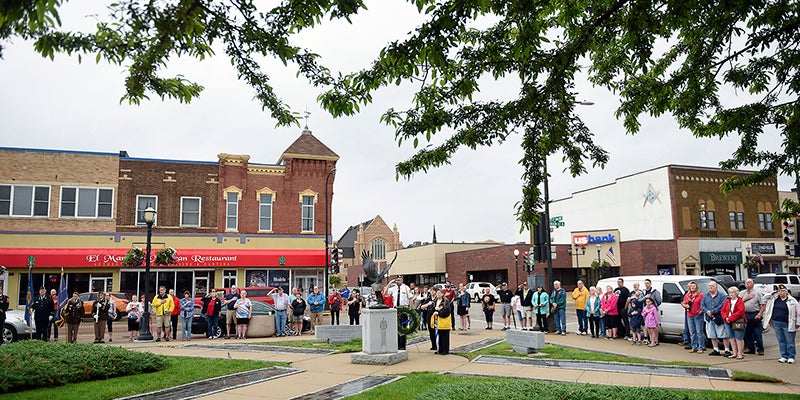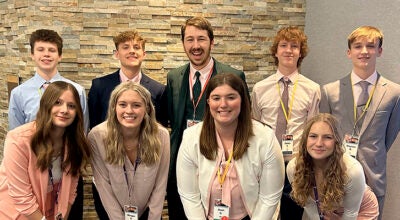Officials host ‘GreenStep Cities’ workshop
Published 7:18 am Thursday, February 25, 2010
It’s not easy being green, but Minnesota officials are aiming to change that.
Austin and Mower County officials hosted a meeting for the Minnesota GreenStep Cities program, which will be a resource for communities that wish to go green.
“It’s a challenge program,” said Philipp Muessig, sustainable communities coordinator with the Minnesota Pollution Control Agency. “For a city like Austin that has really done a lot, it’s a challenge to do more. It’s an assistance program.”
GreenStep Cities will essentially provide networking opportunities for cities to share ideas and practices of going green.
Two meetings were held: one starting at 3 p.m. and a second starting at 6 p.m. About 25 people attended the early meeting Wednesday, including officials from LeRoy, Albert Lea and Owatonna.
While many cities make it a goal to become a sustainable and “green” community, Muessig said a project like GreenStep Cities can help answer a question like: What do we do next?
Southeast Minnesota Clean Energy Resource Teams Coordinator Susan Waughtal will work to introduce the process to cities. She’ll discuss the things a city has accomplished to then develop strategies for the next steps.
“We’ll be able to learn from each other and share each other’s ideas,” Waughtal said. “When we put two things together, it just sparks new ideas. I think it’s just going to be a snowballing effect.”
Best practices
The GreenStep Cities program will split the issues into 27 best practices in areas like buildings and lights, land use, environmental management and economic and community development.
Each of the 27 best practices will have a list of about eight things a city can do using examples from other Minnesota cities. These examples will also include contact information for officials in these cities.
Muessig used the AARP/Blues Zones Vitality Project in Albert Lea as an example. The GreenStep Cities Web site could include a few sentences explaining the vitality project. The site would then include contact information for an official in Albert Lea to call if a city wanted to start its own vitality project.
“Essentially, we want to gather in one place — on one Web site — information on all these 27 best practices for city people and businesses,” Muessig said.
Instead of someone like Austin City Administrator Jim Hurm researching the best ways for the city to make changes, Muessig said the GreenStep Cities Web site would have many examples of what other cities have done.
Muessig said they’re targeting issues and actions that will have multiple benefits for a community.
Along with assisting city leaders, GreenStep will acknowledge successful cities. Muessig compared the program to the Minnesota Star City Program. That program started in the early 1980s and challenged cities to become more engaged in economic development.
“The goal is in three to five years to have 200 GreenStep cities, so we have so much information on the Web site that cities have no excuse to not replicate,” Muessig said.
While the program is designed for cities, Michelle Schroeder, a member of the Minnesota division of the Izaak Walton League of America, said counties and townships can also use the available resources.
“There’s a lot that counties can do on this too,” she said. “The site will be accessible to counties as well, and so a lot of these efforts you’ll be able to access and undertake for yourself as well.”
Such projects aren’t led strictly by government leaders, as community members or groups can introduce ideas, according to Waughtal.
One potential project would be to make street lights more efficient. Another would be to manage storm water contamination, Muessig said.
Muessig said a city like Austin is about halfway to becoming a GreenStep city. However, after the first time a city meets the criteria, he said that city will need to meet another, more difficult set of goals.
The program is designed to be flexible and easy, and Muessig said it will change as cities and those organizing the program learn more.
Funding
Muessig said the program is operating using some funding from the federal stimulus package and some other agencies, but the GreenStep Cities initiative won’t give out grants.
While the program doesn’t directly offer funding, Muessig said the contacts from cities with successful projects will likely know if grant money is available for a certain project.
Cities that implement the 27 best practices may have a higher probability of receiving assistance from AmeriCorps workers in the state, Muessig said.
Some projects and changes will cost money, and Muessig said the aim is to help cities spend money in a smart way. While some programs may cost more upfront, they could be cheaper in the long run because of decreased maintenance costs, he said.
Dave Thompson, residential account representative with Austin Utilities, highlighted some of the many rebates available through Austin Utilities. For example, Thompson said Austin Utilities offers a rebate for planting trees. Some estimates show residences can save energy through strategically placed trees, he said.
Past successes
Acknowledged successes may spur competition between cities, which Schroeder said could inspire cities to act and be involved.
Schroeder highlighted past efforts in Austin, Mower County and other cities.
Austin is the 29th “Cool City” in Minnesota, which means the mayor signed an agreement to reduce greenhouse gas levels to below 1990 levels.
Austin High School was recognized in 2007 as the Environmental Protection Agency’s Energy Star Award Winner for a program to reduce greenhouse gases and saving money.
According to Schroeder, the Grid Neutral Schools Program is also interested in Austin Public Schools. The program aims to keeps schools off the grid by installing solar panels that can also be used for educational purposes.
Geothermal has been utilized in many area buildings. Austin’s Packer Arena was the first arena in the state to use a geothermal system, and Albert Lea City Arena was the second, she said.
More than four wind farms are currently located in Mower County producing about 400 megawatts of energy. The proposed wind farm by Pleasant Valley Wind Company could add an additional 300 megawatts. Freeborn County’s Bent Tree Wind Farm could produce 400 megawatts of energy once completed.




